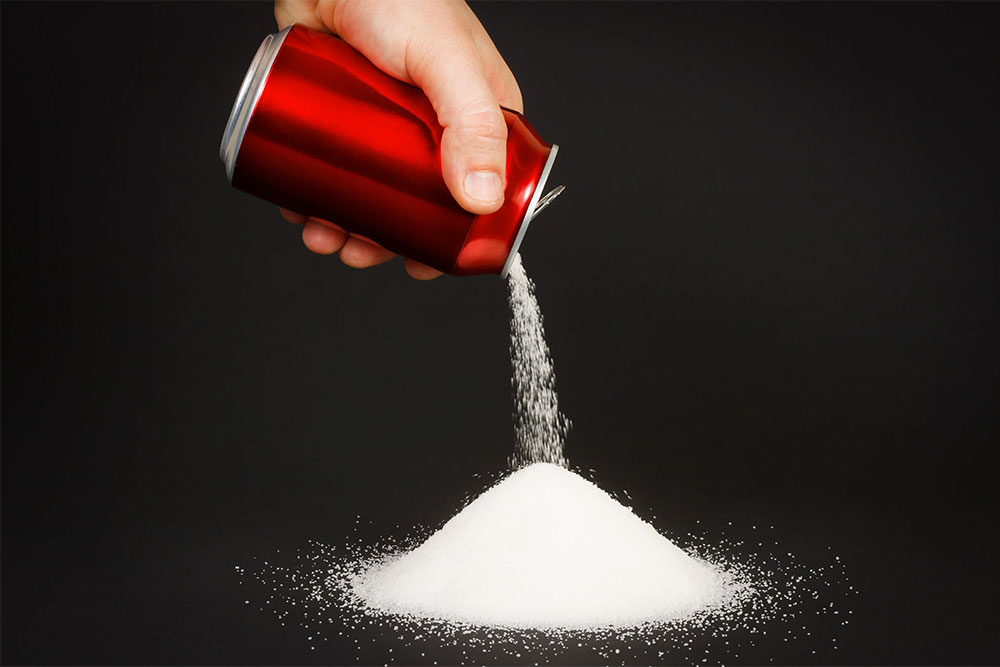Today’s soda drink has evolved since its introduction in the late 1700s. Early on, soda water was marketed as a medicinal drink. Chemists, medical professionals, and pharmacists dabbled with carbonation and medical botany, such as coca leaves (cocaine) and sarsaparilla, to create flavorful mineral water sold as “cure-alls” at drugstores and local soda fountains.
Soda water progressed as drug compounds were removed, marketing strategies revised, and soda formulas honed to create the soda we drink today.

What’s in Today’s Soda?
Regular sodas contain added sugar and lots of it. Most regular 12-ounce sodas contain upwards of 10 teaspoons of sugar, or roughly 40 grams of sugar! Diet sodas, on the other hand, contain artificial sugars and sweeteners, such as aspartame, sucralose, and saccharine (less common).
Other major compounds commonly found in soda are: caffeine, phosphoric/citric acid, 4-methylimidazole (used to achieve the caramel-brown color), sodium benzoate (a preservative and flavor enhancer), and lastly, tap water, which contains unfiltered contaminates. Tap water actually makes up most of soda’s content.
The Trouble with Soda
Soda contains a host of chemicals, many of which cause harmful health effects. The overload of high-fructose corn syrup causes blood sugar levels to spike. The liver then turns excess sugar into fat. Sugar alone causes serious problems with insulin levels (diabetes) and is a major contributing factor to obesity. Although it may seem that diet soda is the “safe soda,” this isn’t true. Artificial sweeteners actually stimulate the appetite and sugar cravings. Just like regular soda, diet soda can cause weight gain and the chronic health issues associated with obesity (e.g., cardiovascular disease, high blood pressure, high cholesterol).
Caffeine elevates blood pressure; too much can also cause headaches and a jittery feeling. The acid in soft drinks is linked with tooth enamel erosion, and recent studies show a correlation between phosphoric acid and osteoporosis. Research continues with preservatives and artificial colors/sweeteners, specifically their health effects, potential carcinogens they contain, and safe levels of consumption.
With better access to public health information, many people in the United States have rightfully chosen to stop drinking soda all together. Due to this decrease in soda consumption, it has become advantageous for soda companies to market new kinds of drinks in the U.S., but many of these flavored waters and energy drinks still contain sugar and artificial sweeteners. Soda companies have also boosted their marketing and sales in foreign countries as a result of these changing trends. Certainly the message is to buy a “refreshing” drink, but the potential negative health effects of drinking soda tell a different story.
Wiseman Health Take-Home Advice
In order to achieve optimal health, it is paramount that sodas are addressed in your diet. It is best to take them out altogether, but at the very least they need to be put in the dessert category, which means they should only be consumed every once in a while. We recommend that you decrease your total sugar intake from all foods to less than 30 grams a day (one 12-ounce soda contains almost 40 grams of sugar). To avoid the sugar and harmful chemicals in regular and diet sodas, reach for filtered water or unsweetened drinks like tea.
Introduction to Pop—The History of Soft Drinks (Updated 2016, February 03) inventors.about.com. Retrieved March 9, 2016 from http://inventors.about.com/od/foodrelatedinventions/a/soft_drinks.htm
How Much Is Too Much? SugarScience.org. Retrieved March 9, 2016 from http://www.sugarscience.org/the-growing-concern-of-overconsumption/?searched=soda&advsearch=allwords&highlight=ajaxSearch_highlight+ajaxSearch_highlight1#.VuB9c1I56u4
Caramel color: the health risk that may be in your soda (2014, February 10) consumerreports.org. Retrieved March 9, 2016 from http://www.consumerreports.org/cro/news/2014/01/caramel-color-the-health-risk-that-may-be-in-your-soda/index.htm
Galland, J. (2012, June 11) Worse Than Sugar: What’s in Your Soda? huffingtonpost.com. Retrieved March 9, 2016 from http://www.huffingtonpost.com/jonathan-galland/hfcs-soda_b_1581123.html
Yang, Q. (2010, June) Gain weight by “going diet?” Artificial sweeteners and the neurobiology of sugar cravings. Yale Journal of Biology and Medicine. Retrieved March 9, 2016 from http://www.ncbi.nlm.nih.gov/pmc/articles/PMC2892765/
Mercola, J. (2016, February 24) Soda Giants Shift Attention to Developing Nations to Make Up for Shrinking Profits. articles.mercola.com. Retrieved March 9, 2016 from http://articles.mercola.com/sites/articles/archive/2016/02/24/soda-consumption-weight-gain.aspx
Wells, S. D. (2011, September 29) Sodium benzoate is a preservative that promotes cancer and kills healthy cells. naturalnews.com. Retrieved March 9, 2016 from http://www.naturalnews.com/033726_sodium_benzoate_cancer.html#
Tucker et al,. (October 2006) Colas, but not other carbonated beverages, are associated with low bone mineral density in older women: The Framingham Osteoporosis Study. Retrieved March 9, 2016 from http://www.ncbi.nlm.nih.gov/pubmed/17023723

Keep sending out great content!
Dr. W, Coke is my ONE thing. I’ve given up everything. Now our H2O is causing problems. Fill you in on that later. Sigh 🙁